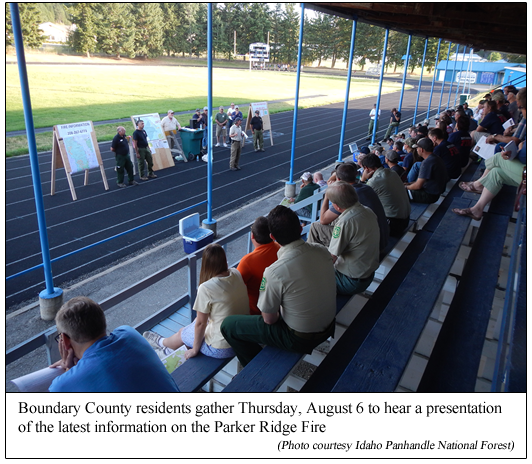|
|
|
Community Meeting provides information about
Parker Ridge Fire |
|
August 8, 2015 |
by McKenzie MacDonald
The Parker Ridge Fire continues to burn at the
top of Parker Ridge, ignited by a lightning
strike on July 29. Now at 263 acres, the fire
has more than doubled in size over the past few
days, still with 0% containment.
While there is currently a lot of communication
between the community and those working to
control this fire, it is very difficult to reach
out to everyone. Thursday night (August 6), a
community meeting was held at Bonners Ferry High
School’s football field to help facilitate that
communication between fire and lands officials
and the residents of Boundary County. “If we
don’t know what’s going on, we’ll imagine the
worst,” said Norm Rooker, a responder from
Colorado. “We need to share the reality of
what’s going on.”
Forty-four Boundary County residents took
advantage of the opportunity to attend the
meeting and learn details about the Parker Ridge
Fire. According to fire officials, the goal of
Thurday's community meeting was "to brief
members of the public, share results of the
ongoing operations, discuss other assessments of
the Parker Ridge Fire, and go over the current
and upcoming operative plans."
To that end, there was much explanation about
what the fire is currently doing, what it is
expected to do, the efforts that are being made
to keep it under control, and what citizens can
do to prepare their homes in the event of an
emergency evacuation.

What is the fire doing currently?
As of yesterday morning (August 7), the fire
covers approximately 263 acres and is 0%
contained. Since last week when it was first
detected, fire activity has been increasing due
to harsher winds. The extreme amount of dead,
standing lodgepole pine trees has also not
helped the issue. Aside from adding fuel to the
fire, these dead trees are very unstable and
have the potential to fall over without warning,
making for conditions that are unsafe for any
firefighting attempts on the ground. Therefore,
continued efforts to slow the fire down are
being made by using the aircraft resources that
have been provided.
What is the fire expected to do in the
coming days?
Currently the high temperatures and dry
conditions we are experiencing have been record
breaking. We have not seen conditions like these
in this community for over 50 years, and we are
a month ahead of when we would typically be
seeing conditions similar to these. It is
anticipated that it will only continue to get
hotter and dryer. However, the Spokane Weather
Service reports that we should not expect any
extremely high heat or winds within the next
seven days. Even without high heat or winds, the
fire will continue to spread, but the hope is
that the responders can use that time to get a
handle on it by continuing to use the aircraft.
What is the plan for getting this fire
under control?
As noted above, there is currently nobody on the
ground fighting this fire. The safety concerns
and the location of the fire itself make it
impossible to safely fly anyone in because there
is nowhere safe to land. “We will never trade
lives for trees,” said Forest Service district
ranger Kevin Knauth. Still, a lot of effort is
being made from the air. On the first afternoon
alone of attacking the fire, 24,000 gallons of
water were used in an attempt to stop it early.
Since then, responders have been consistently
dumping water and fire retardant on and around
the fire in an attempt to “box it in,” said
Knauth.
Even with it boxed in, the fire must continue to
spread in order to provide conditions that will
make it safe enough for firefighters to work on
it from the ground. Right now, there is a lot of
waiting, monitoring, scouting, and preparing
happening to ensure the safety of both the
community and the potential on-the-ground
responders.
How can citizens be prepared in the case
of a necessary evacuation?
At the very earliest, the fire could possibly
put structures at risk in the next five days,
but that is in the case of extreme weather
conditions. Realistically, the estimate is
between seven and eight days. Nonetheless, the
responders would like the community to “think
tomorrow.” South Boundary Fire Department Chief
Tony Rohrwasser provided many precautions to
take in order to be prepared for an emergency
evacuation:
1. Look on your deck and around a radius of at
least five feet from your home. Is there
anything that could potentially fuel a fire
(bark, dry weeds, lawn furniture, etc.)?
2. Make a list of important things that you
CANNOT forget in the case of an evacuation
(social security cards, cell phone chargers,
etc.).
3. Sit down with your family and put together a
communication and evacuation plan.
4. Carry your car keys with you at all times.
5. Locate your pets and keep them nearby.
Arrange the transportation of any livestock to a
safe location.
6. Clear out your driveway and park all vehicles
facing so that it is a straight shot to the road
– no reverse necessary.
7. Research load limits on any private bridges.
Responders cannot cross any bridges unless they
are aware of the load limit.
8. Listen to a radio or scanner – Bonners Ferry
is connected with Nixle which, upon
registration, provides notifications from the
Sheriff’s department to your cell phone
(nixle.com)
9. If you are asked to evacuate, please do so.
It is for your own safety and for the safety of
the responders.
For a checklist that provides further detail,
please visit:
http://www.readyforwildfire.org/pre-evacuation_preparation
For further information or to ask a question
about this fire, contact information is provided
below:
Information Phone: 208-267-6773
Email:
parkerridgefireinfo@gmail.com
Webpage:
http://inciweb.nwcg.gov/incident/4432/
Facebook:
http://www.facebook.com/USFSIPNF |
|
|
|
Questions or comments about this
article?
Click here to e-mail! |
|
|
|
|

